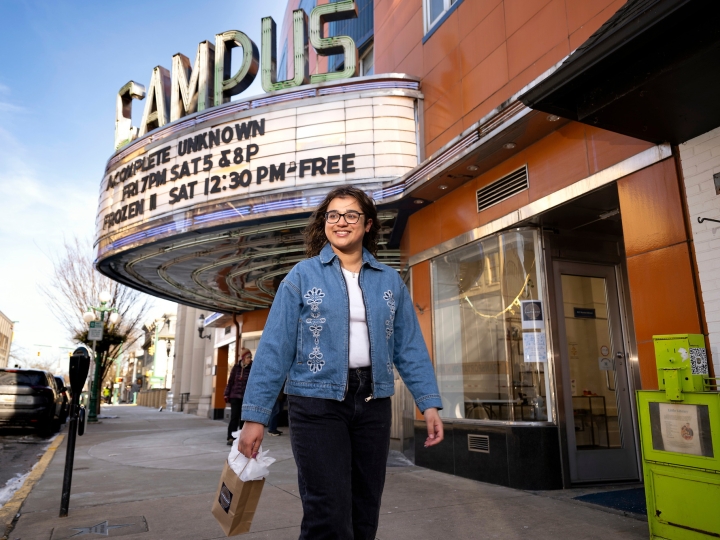For Art's Sake
April 16, 2016
Imagine you’re a student musician with the chance to learn from a significant composer. Each year at Bucknell, Jazz Ensemble members not only work with a musical artist but also play a piece the composer has been commissioned to create just for them — personally conducted during the artist’s residency on campus.
The Charles J. and Isabelle Kushell Music Endowment Fund has made such experiences possible since 1971. “It really attracted me to come teach here,” says Professor Barry Long, music, who first learned of the resource during his job interview. The Kushell fund is among several that elevate both the student experience and the arts on campus and in the surrounding community.
Since joining the faculty in 2008, Long has taken full advantage of the Kushell fund. Nearly every summer, he sends recordings of the Jazz Ensemble to a composer, such as jazzman Dean Sorenson, who creates a piece that takes advantage of members’ talents and challenges them to play in new directions. After practicing the music for months, the students are ready for the composer’s spring residency. They rehearse under the direction of the composer, then publicly perform the work.
“When the composer is there to talk through his or her thought process, it’s a whole new level of teaching for the students that reinforces what we do as faculty,” says Long. “It’s way beyond the typical undergraduate experience.”
Personal lessons and feedback from visiting artists influenced Christian Humcke ’15, who majored in music composition and is continuing his studies at the Peabody Institute of Johns Hopkins University. “Guest artists give you a fresh perspective on what the faculty teaches us,” he says. “When they explain something in a slightly different way, it can make a really big impact.”
The fund was established through a gift from the late Charles ’27, H’71 and Isabelle Coopey Kushell ’27, G’77. It has enriched the music department’s offerings, from classical and world to jazz and contemporary music. Professor Bill Kenny, the department chair, still recalls the impact of Kushell artist Joan La Barbara, an avant-garde vocalist who collaborated with composer John Cage.
“Her approach was so fresh and so commanding that it made me step back and look at how I was teaching my foundation seminar,” he says. “It was a turning point for some of my students, and for me.”
The Stadler Center for Poetry also benefits from endowments that support visiting writers. Its Poet-in-Residence program was originally funded in part by the late Jack Stadler '40. His son, Jack ’75, carries on the tradition of supporting the Stadler Center. The program funds visits from the likes of celebrated poets Mark Doty and, most recently, Claudia Rankine. Poets participate in readings and panels, teach a master class and work directly with students for a week.

As a creative writing major, Tyler Mills ’05 worked with Stadler poets-in-residence.
“We were regarded as real poets, which was incredible. It made me feel that I could make a life in poetry, whatever that might mean,” she recalls. Now an award-winning poet who founded a journal and teaches at New Mexico Highlands University, Mills returned to the Stadler in 2013 to read her work.
Another Stadler gift-based initiative is a fellowship for emerging poets who receive training in arts administration and literary editing while working on their first book of poetry. Also created and supported by members of the Stadler family, it’s a prestigious two-year post that offers a rare opportunity to an outstanding recent MFA graduate.
The Sandra and Gary Sojka Visiting Poet Series, sponsored by the Bucknell president emeritus and his wife, brings a distinguished poet to campus for several days each fall to give a reading and to interact with students. The most recent visiting poet was Cole Swensen, a Guggenheim Fellow.
Music and the literary arts aren’t the only beneficiaries of generous endowments. Recent gifts from John ’64 and Sandy Lyttle Nesbitt ’64, P’94, have allowed the Department of Art & Art History and the Samek Art Museum to establish programs for visiting visual artists. Every other year, the Nesbitt Artist Residency Program will bring an artist-in-residence to campus to spend a month working in a studio that is open to the public for two hours per week.
“This is a living lab,” says Professor Tulu Bayar, art. The work produced by multimedia artist Shani Peters during the first residency is on display in Academic West through May 1.
A gift from Ed ’58 and Martie Lauver Samek ’60, P’86, P’88, P’91 last year created the Samek Distinguished Art Lecture Series, which showcases art-world luminaries — visual artists, curators and writers —who give a public talk and work with students. The first guest, art historian John Wilmerding, was a director of the National Gallery of Art and curated the celebrated Crystal Bridges Museum of American Art in Bentonville, Ark. This year’s guest, scheduled to speak April 21, is Lowery Stokes Sims, the first African-American curator at the Metropolitan Museum of Art and recently retired chief curator at the Museum of Arts & Design in New York City.
“We envisioned the series as an opportunity to bring highly accomplished individuals with different experiences in the art world to share their views,” says Ed Samek. “It’s a chance to reach out beyond campus to the community and enhance Bucknell’s national reputation.”

